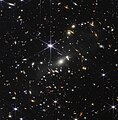پەڕگە:Webb's First Deep Field.jpg

قەبارەی ئەم پێشبینینە: ٥٨٧ لە ٥٩٩ پیکسەڵ. ڕێزەلووشنەکانی تر: ٢٣٥ لە ٢٤٠ پیکسەڵ | ٤٧٠ لە ٤٨٠ پیکسەڵ | ٧٥٣ لە ٧٦٨ پیکسەڵ | ١٬٠٠٣ لە ١٬٠٢٤ پیکسەڵ | ٢٬٠٠٧ لە ٢٬٠٤٨ پیکسەڵ | ٤٬٥٣٧ لە ٤٬٦٣٠ پیکسەڵ.
پەڕگەی سەرەکی (٤٬٥٣٧ × ٤٬٦٣٠ پیکسڵ، قەبارەی پەڕگە: ١٦٫٤٣ مێگابایت، جۆری ئێم ئای ئێم ئی: image/jpeg)
مێژووی پەڕگە
کرتە بکە لەسەر یەکێک لە ڕێکەوت/کاتەکان بۆ بینینی پەڕگەکە بەو شێوەی لەو کاتەدا بووە.
| ڕێکەوت/کات | ھێما | ئەندازە | بەکارھێنەر | تێبینی | |
|---|---|---|---|---|---|
| هەنووکە | ١٢:١٤، ٢٢ی ئەیلوولی ٢٠٢٢ |  | ٤٬٥٣٧ لە ٤٬٦٣٠ (١٦٫٤٣ مێگابایت) | Habitator terrae | better quality |
| ٢٢:٥٤، ١١ی تەممووزی ٢٠٢٢ |  | ٤٬٥٣٧ لە ٤٬٦٣٠ (١٫٨٦ مێگابایت) | Habitator terrae | {{JPEG version of TIF}} {{Information |description={{en|1=NASA’s James Webb Space Telescope has produced the deepest and sharpest infrared image of the distant universe to date. Known as Webb’s First Deep Field, this image of galaxy cluster SMACS 0723 is overflowing with detail. Thousands of galaxies – including the faintest objects ever observed in the infrared – have appeared in Webb’s view for the first time. This slice of the vast universe is approximately the size of a grain of sand hel... |
بەکارھێنانی پەڕگە
ئەم پەڕەیە ئەم پەڕگەیە بەکار دەھێنێت:
بەکارھێنانی سەرانسەریی پەڕگە
ئەم ویکیانەی دیکەی خوارەوەش ئەم پەڕگە بەکاردێنن:
- بەکارھێنان لە ar.wikipedia.org
- بوابة:علم الفلك
- مقراب جيمس ويب الفضائي
- أعمدة الخلق
- مركز غودارد لرحلات الفضاء
- وكالة الفضاء الكندية
- ويكيبيديا:صور مختارة/الفضاء والكون/نظرة إلى الأعلى
- بوابة:علم الفلك/صورة مختارة
- بوابة:علم الفلك/قوالب
- جيمس إدوين ويب
- معهد مراصد علوم الفضاء
- قائمة الحقول العميقة
- قالب:مقراب جيمس ويب الفضائي
- بوابة:علم الكواكب خارج المجموعة الشمسية/قوالب
- بوابة:علم الكواكب خارج المجموعة الشمسية
- درع شمسي لمقراب جيمس ويب الفضائي
- كاميرا نيركام
- كاميرا ميري (للأشعة تحت الحمراء المتوسطة)
- مطياف نير
- الحقل العميق الأول لويب
- عنقود مجرات SMACS 0723
- ويكيبيديا:ترشيحات الصور المختارة/الحقل العميق الأول لويب
- ويكيبيديا:صورة اليوم المختارة/أغسطس 2022
- قالب:صورة اليوم المختارة/2022-08-15
- بوابة:علم الفلك/صورة مختارة/81
- سيرس-93316
- بەکارھێنان لە as.wikipedia.org
- بەکارھێنان لە av.wikipedia.org
- بەکارھێنان لە az.wikipedia.org
- بەکارھێنان لە be.wikipedia.org
- بەکارھێنان لە bg.wikipedia.org
- بەکارھێنان لە bn.wikipedia.org
- بەکارھێنان لە ca.wikipedia.org
- بەکارھێنان لە cs.wikipedia.org
- بەکارھێنان لە de.wikipedia.org
بینینی بەکارھێنانی گشتی زیاتری ئەم پەڕگەیە.



